Sensory Evaluation and Physicochemical Analysis of Beers with Old Sardinian Wheats
Abstract
1. Introduction
2. Materials and Methods
2.1. Beer Production
2.2. Standard Quality Attributes of Beers
2.3. Analysis of Beer Volatile Organic Compounds (VOCs)
2.4. Sensorial Analysis
2.4.1. Quantitative Descriptive Analysis
2.4.2. Consumer Study
2.4.3. Consumer’s Preference and Attitude Toward Craft Beer Consumption
2.5. Statistical Analysis
3. Results
3.1. Characterization of Beers
3.2. Sensorial Characterization
3.2.1. Quantitative Descriptive Analysis
3.2.2. Check-All-That-Apply Analysis
3.2.3. Correspondence Analysis
3.2.4. Consumer Acceptance
3.2.5. Cluster Analysis
4. Discussion
5. Conclusions
Supplementary Materials
Author Contributions
Funding
Institutional Review Board Statement
Informed Consent Statement
Data Availability Statement
Acknowledgments
Conflicts of Interest
Abbreviations
| CA | Correspondence analysis |
| CATA | Check-All-That-Apply |
| GAE | Gallic acid equivalent |
| GC-MS | Gas chromatography–mass spectrometry |
| HS-SPME | Head-space solid-phase microextraction |
| IPM | Internal preference mapping |
| PCA | Principal Component Analysis |
| PTFE | Polytetrafluoroethylene |
| QDA | Quantitative Descriptive Analysis |
| TPC | Total Polyphenol Content |
| VOC | Volatile Organic Compounds |
References
- Arzani, A.; Ashraf, M. Cultivated Ancient Wheats (Triticum spp.): A Potential Source of Health-Beneficial Food Products. Compr. Rev. Food Sci. Food Saf. 2017, 16, 477–488. [Google Scholar] [CrossRef]
- De Santis, M.A.; Kosik, O.; Passmore, D.; Flagella, Z.; Shewry, P.R.; Lovegrove, A. Comparison of the dietary fibre composition of old and modern durum wheat (Triticum turgidum spp. durum) genotypes. Food Chem. 2018, 244, 304–310. [Google Scholar] [CrossRef] [PubMed]
- Dinu, M.; Whittaker, A.; Pagliai, G.; Benedettelli, S.; Sofi, F. Ancient wheat species and human health: Biochemical and clinical implications. J. Nutr. Biochem. 2018, 52, 1–9. [Google Scholar] [CrossRef] [PubMed]
- Albanese, L.; Ciriminna, R.; Meneguzzo, F.; Pagliaro, M. Innovative beer-brewing of typical, old and healthy wheat varieties to boost their spreading. J. Clean. Prod. 2018, 171, 297–311. [Google Scholar] [CrossRef]
- García-Puebla, C.A.; Heredia-Olea, E.; López-Córdova, J.P.; Dórame-Miranda, R.F.; Padilla-Torres, C.V.; Rodríguez Félix, F.; López-Ahumada, G.A. Use of durum wheat (Triticum durum L.) with “yellow berry” as an alternative to malts in the production of ale-type beer: Physicochemical, quality of malts, and sensorial analysis. J. Cereal Sci. 2023, 109, 103613. [Google Scholar] [CrossRef]
- Mayer, H.; Marconi, O.; Perretti, G.; Sensidoni, M.; Fantozzi, P. Investigation of the Suitability of Hulled Wheats for Malting and Brewing. J. Am. Soc. Brew. Chem. 2011, 69, 116–120. [Google Scholar] [CrossRef]
- Benedetti, P.; Salvi, S.; Giomo, A.; Van Deun, R.; Boselli, E.; Frega, N. Taste-Active Components of Beers from Emmer Wheat (Triticum dicoccum) Malt. Sci. Agric. Bohem. 2016, 47, 82–89. [Google Scholar] [CrossRef]
- Mayer, H.; Ceccaroni, D.; Marconi, O.; Sileoni, V.; Perretti, G.; Fantozzi, P. Development of an all rice malt beer: A gluten free alternative. LWT–Food Sci. Technol. 2016, 67, 67–73. [Google Scholar] [CrossRef]
- Mongelli, A.; Rodolfi, M.; Ganino, T.; Marieschi, M.; Caligiani, A.; Dall’Asta, C.; Bruni, R. Are Humulus lupulus L. ecotypes and cultivars suitable for the cultivation of aromatic hop in Italy? A phytochemical approach. Ind. Crops Prod. 2016, 83, 693–700. [Google Scholar] [CrossRef]
- Rossini, F.; Loreti, P.; Provenzano, M.E.; De Santis, D.; Ruggeri, R. Agronomic Performance and Beer Quality Assessment of Twenty Hop Cultivars Grown in Central Italy. Ital. J. Agron. 2016, 11, 746. [Google Scholar] [CrossRef]
- Alfeo, V.; Jaskula-Goiris, B.; Venora, G.; Schimmenti, E.; Aerts, G.; Todaro, A. Screening of durum wheat landraces (Triticum turgidum subsp. durum) for the malting suitability. J. Cereal Sci. 2018, 83, 101–109. [Google Scholar] [CrossRef]
- Forteschi, M.; Porcu, M.C.; Fanari, M.; Zinellu, M.; Secchi, N.; Buiatti, S.; Passaghe, P.; Bertoli, S.; Pretti, L. Quality assessment of Cascade Hop (Humulus lupulus L.) grown in Sardinia. Eur. Food Res. Technol. 2019, 245, 863–871. [Google Scholar] [CrossRef]
- Gugino, I.M.; Alfeo, V.; Ashkezary, M.R.; Marconi, O.; Pirrone, A.; Francesca, N.; Cincotta, F.; Verzera, A.; Todaro, A. Maiorca wheat malt: A comprehensive analysis of physicochemical properties, volatile compounds, and sensory evaluation in brewing process and final product quality. Food Chem. 2024, 435, 137517. [Google Scholar] [CrossRef]
- Ruggeri, R.; Rossini, F.; Roberto, S.R.; Sato, A.J.; Loussert, P.; Rutto, L.K.; Agehara, S. Development of hop cultivation in new growing areas: The state of the art and the way forward. Eur. J. Agron. 2024, 161, 127335. [Google Scholar] [CrossRef]
- Gugino, I.M.; Pirrone, A.; Lo Porto, L.G.; Giammusso, N.; Alfeo, V.; De Rouck, G.; Francesca, N.; Todaro, A. Optimizing malting conditions for the old Sicilian durum wheat landrace Perciasacchi: Effects of steeping time and temperature on malt and beer quality. LWT 2025, 216, 117361. [Google Scholar] [CrossRef]
- Herb, D.; Filichkin, T.; Fisk, S.; Helgerson, L.; Hayes, P.; Benson, A.; Vega, V.; Carey, D.; Thiel, R.; Cistue, L.; et al. Malt Modification and its Effects on the Contributions of Barley Genotype to Beer Flavor. J. Am. Soc. Brew. Chem. 2017, 75, 354–362. [Google Scholar] [CrossRef]
- Parenti, O.; Carini, E.; Cattaneo, C.; Dall’Asta, M.; Laureati, M.; Scazzina, F.; Fascioli, D.; Chiavaro, E. Preserving Triticum biodiversity: High technological, nutritional, and sensory quality of whole wheat pasta from ancient, old, and evolutionary wheat varieties. LWT 2025, 228, 118065. [Google Scholar] [CrossRef]
- Frankin, S.; Cna’ani, A.; Bonfil, D.J.; Tzin, V.; Nashef, K.; Degen, D.; Simhon, Y.; Baizerman, M.; Ibba, M.I.; González Santoyo, H.I.; et al. New flavors from old wheats: Exploring the aroma profiles and sensory attributes of local Mediterranean wheat landraces. Front. Nutr. 2023, 10, 1059078. [Google Scholar] [CrossRef]
- Shewry, P.R. Do ancient types of wheat have health benefits compared with modern bread wheat? J. Cereal Sci. 2018, 79, 469–476. [Google Scholar] [CrossRef]
- Shewry, P.R.; Hey, S. Do “ancient” wheat species differ from modern bread wheat in their contents of bioactive components? J. Cereal Sci. 2015, 65, 236–243. [Google Scholar] [CrossRef]
- Boukid, F.; Dall’Asta, M.; Bresciani, L.; Mena, P.; Del Rio, D.; Calani, L.; Sayar, R.; Seo, Y.W.; Yacoubi, I.; Mejri, M. Phenolic profile and antioxidant capacity of landraces, old and modern Tunisian durum wheat. Eur. Food Res. Technol. 2019, 245, 73–82. [Google Scholar] [CrossRef]
- Dinelli, G.; Segura Carretero, A.; Di Silvestro, R.; Marotti, I.; Fu, S.; Benedettelli, S.; Ghiselli, L.; Fernández Gutiérrez, A. Determination of phenolic compounds in modern and old varieties of durum wheat using liquid chromatography coupled with time-of-flight mass spectrometry. J. Chromatogr. A 2009, 1216, 7229–7240. [Google Scholar] [CrossRef]
- Garavaglia, C.; Swinnen, J. Economics of the Craft Beer Revolution: A Comparative International Perspective. In Economic Perspectives on Craft Beer: A Revolution in the Global Beer Industry; Garavaglia, C., Swinnen, J., Eds.; Springer International Publishing: Cham, Switzerland, 2018; pp. 3–51. [Google Scholar]
- Alfeo, V.; De Francesco, G.; Sileoni, V.; Blangiforti, S.; Palmeri, R.; Aerts, G.; Perretti, G.; Todaro, A. Physicochemical properties, sugar profile, and non-starch polysaccharides characterization of old wheat malt landraces. J. Food Compos. Anal. 2021, 102, 103997. [Google Scholar] [CrossRef]
- De Flaviis, R.; Santarelli, V.; Giuliani, M.; Neri, L.; Sacchetti, G. Influence of wheat content and origin on the volatilome of craft wheat beer: An investigation by combined multivariate statistical approaches. Food Res. Int. 2024, 191, 114709. [Google Scholar] [CrossRef] [PubMed]
- Giunta, F.; Pruneddu, G.; Motzo, R. Grain yield and grain protein of old and modern durum wheat cultivars grown under different cropping systems. Field Crops Res. 2019, 230, 107–120. [Google Scholar] [CrossRef]
- Gómez-Corona, C.; Escalona-Buendía, H.B.; García, M.; Chollet, S.; Valentin, D. Craft vs. industrial: Habits, attitudes and motivations towards beer consumption in Mexico. Appetite 2016, 96, 358–367. [Google Scholar] [CrossRef] [PubMed]
- Aquilani, B.; Laureti, T.; Poponi, S.; Secondi, L. Beer choice and consumption determinants when craft beers are tasted: An exploratory study of consumer preferences. Food Qual. Prefer. 2015, 41, 214–224. [Google Scholar] [CrossRef]
- Bimbo, F.; De Meo, E.; Baiano, A.; Carlucci, D. The Value of Craft Beer Styles: Evidence from the Italian Market. Foods 2023, 12, 1328. [Google Scholar] [CrossRef]
- Gómez-Corona, C.; Escalona-Buendía, H.B.; Chollet, S.; Valentin, D. The building blocks of drinking experience across men and women: A case study with craft and industrial beers. Appetite 2017, 116, 345–356. [Google Scholar] [CrossRef]
- Donadini, G.; Fumi, M.D.; Kordialik-Bogacka, E.; Maggi, L.; Lambri, M.; Sckokai, P. Consumer interest in specialty beers in three European markets. Food Res. Int. 2016, 85, 301–314. [Google Scholar] [CrossRef]
- Mefleh, M.; Conte, P.; Fadda, C.; Giunta, F.; Piga, A.; Hassoun, G.; Motzo, R. From ancient to old and modern durum wheat varieties: Interaction among cultivar traits, management, and technological quality. J. Sci. Food Agric. 2019, 99, 2059–2067. [Google Scholar] [CrossRef]
- Agenzia Laore. Sardegna—Repertorio Regionale Dell’Agrobiodiversità. Available online: https://www.biodiversitasardegna.it/laore/it/agrobiodiversita/repertorio-regionale/ (accessed on 6 August 2025).
- Vaccino, P.M. Francesco I frumenti teneri locali della Sardegna: Un’inaspettata riscoperta, le iniziative di valorizzazione. Analysis 2018, 2. [Google Scholar]
- European Brewery Convention (EBC) (Ed.) 9.6—Colour of Beer: Spectrophotometric Method (IM). In Analytica; Fachverlag Hans Carl: Nürnberg, Germany, 2004. [Google Scholar]
- European Brewery Convention (EBC) (Ed.) 9.42—Foam Stability of Beer using the NIBEM-T Meter. In Analytica; Fachverlag Hans Carl: Nürnberg, Germany, 2007. [Google Scholar]
- Singleton, V.L.; Rossi, J.A. Colorimetry of Total Phenolics with Phosphomolybdic-Phosphotungstic Acid Reagents. Am. J. Enol. Viticult 1965, 16, 144–158. [Google Scholar] [CrossRef]
- Ligor, M.; Stankevičius, M.; Wenda-Piesik, A.; Obelevičius, K.; Ragažinskienė, O.; Stanius, Ž.; Maruška, A.; Buszewski, B. Comparative Gas Chromatographic–Mass Spectrometric Evaluation of Hop (Humulus lupulus L.) Essential Oils and Extracts Obtained Using Different Sample Preparation Methods. Food Anal. Methods 2014, 7, 1433–1442. [Google Scholar] [CrossRef]
- ISO 8589; Sensory Analysis—General Guidance for the Design of Test Rooms. International Organization for Standardization (ISO): Geneva, Switzerland, 2007.
- Yorke, J.; Cook, D.; Ford, R. Brewing with Unmalted Cereal Adjuncts: Sensory and Analytical Impacts on Beer Quality. Beverages 2021, 7, 4. [Google Scholar] [CrossRef]
- ISO 8586; Sensory Analysis—Selection and Training of Sensory Assessors. International Organization for Standardization (ISO): Geneva, Switzerland, 2023.
- ISO 13299; Sensory Analysis—Methodology—General Guide to Defining a Sensory Profile. International Organization for Standardization (ISO): Geneva, Switzerland, 2016.
- Murray, J.M.; Delahunty, C.M.; Baxter, I.A. Descriptive sensory analysis: Past, present and future. Food Res. Int. 2001, 34, 461–471. [Google Scholar] [CrossRef]
- Tomic, O.; Luciano, G.; Nilsen, A.; Hyldig, G.; Lorensen, K.; Næs, T. Analysing sensory panel performance in a proficiency test using the PanelCheck software. Eur. Food Res. Technol. 2010, 230, 497–511. [Google Scholar] [CrossRef]
- Jaeger, S.R.; Chheang, S.L.; Yin, J.; Bava, C.M.; Gimenez, A.; Vidal, L.; Ares, G. Check-all-that-apply (CATA) responses elicited by consumers: Within-assessor reproducibility and stability of sensory product characterizations. Food Qual. Prefer. 2013, 30, 56–67. [Google Scholar] [CrossRef]
- Dooley, L.; Lee, Y.-S.; Meullenet, J.-F. The application of check-all-that-apply (CATA) consumer profiling to preference mapping of vanilla ice cream and its comparison to classical external preference mapping. Food Qual. Prefer. 2010, 21, 394–401. [Google Scholar] [CrossRef]
- Ares, G.; Jaeger, S.R. Check-all-that-apply questions: Influence of attribute order on sensory product characterization. Food Qual. Prefer. 2013, 28, 141–153. [Google Scholar] [CrossRef]
- Meilgaard, M.; Civille, G.V.; Carr, B.T. Sensory Evaluation Techniques; CRC Press: Boca Raton, FL, USA, 2006; p. 464. [Google Scholar]
- Chung, S.-J.; Heymann, H.; Grün, I.U. Application of GPA and PLSR in correlating sensory and chemical data sets. Food Qual. Prefer. 2003, 14, 485–495. [Google Scholar] [CrossRef]
- De Flaviis, R.; Santarelli, V.; Mutarutwa, D.; Grilli, S.; Sacchetti, G. A unifying approach to wheat beer flavour by chemometric analyses. Could we speak of ‘terroir’? Curr. Res. Food Sci. 2023, 6, 100429. [Google Scholar] [CrossRef]
- Elgaard, L.; Mielby, L.A.; Hopfer, H.; Byrne, D.V. A Comparison of Two Sensory Panels Trained with Different Feedback Calibration Range Specifications via Sensory Description of Five Beers. Foods 2019, 8, 534. [Google Scholar] [CrossRef]
- Gower, J.C. Generalized procrustes analysis. Psychometrika 1975, 40, 33–51. [Google Scholar] [CrossRef]
- Leedon, G.; L’Espoir Decosta, J.-N.P.; Buttriss, G.; Lu, V.N. Consuming the earth? Terroir and rural sustainability. J. Rural Stud. 2021, 87, 415–422. [Google Scholar] [CrossRef]
- Castelló, E. The will for terroir: A communicative approach. J. Rural Stud. 2021, 86, 386–397. [Google Scholar] [CrossRef]

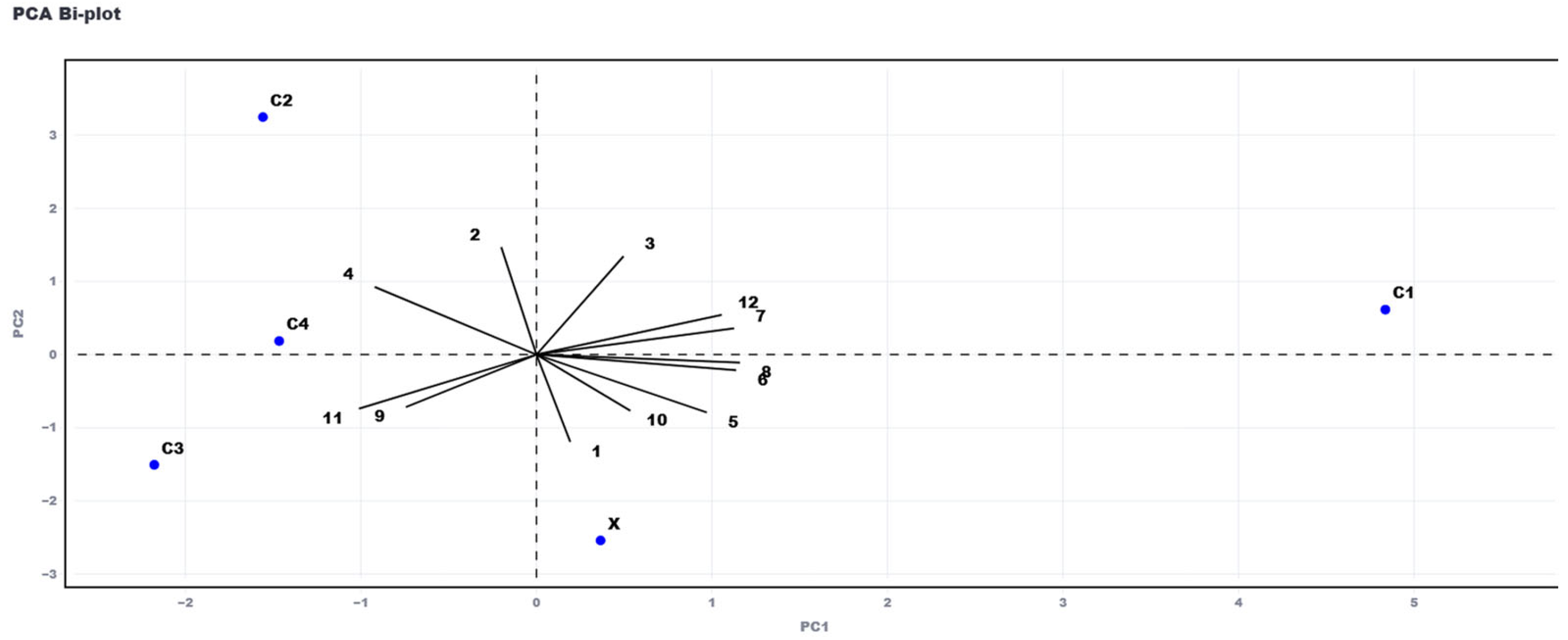
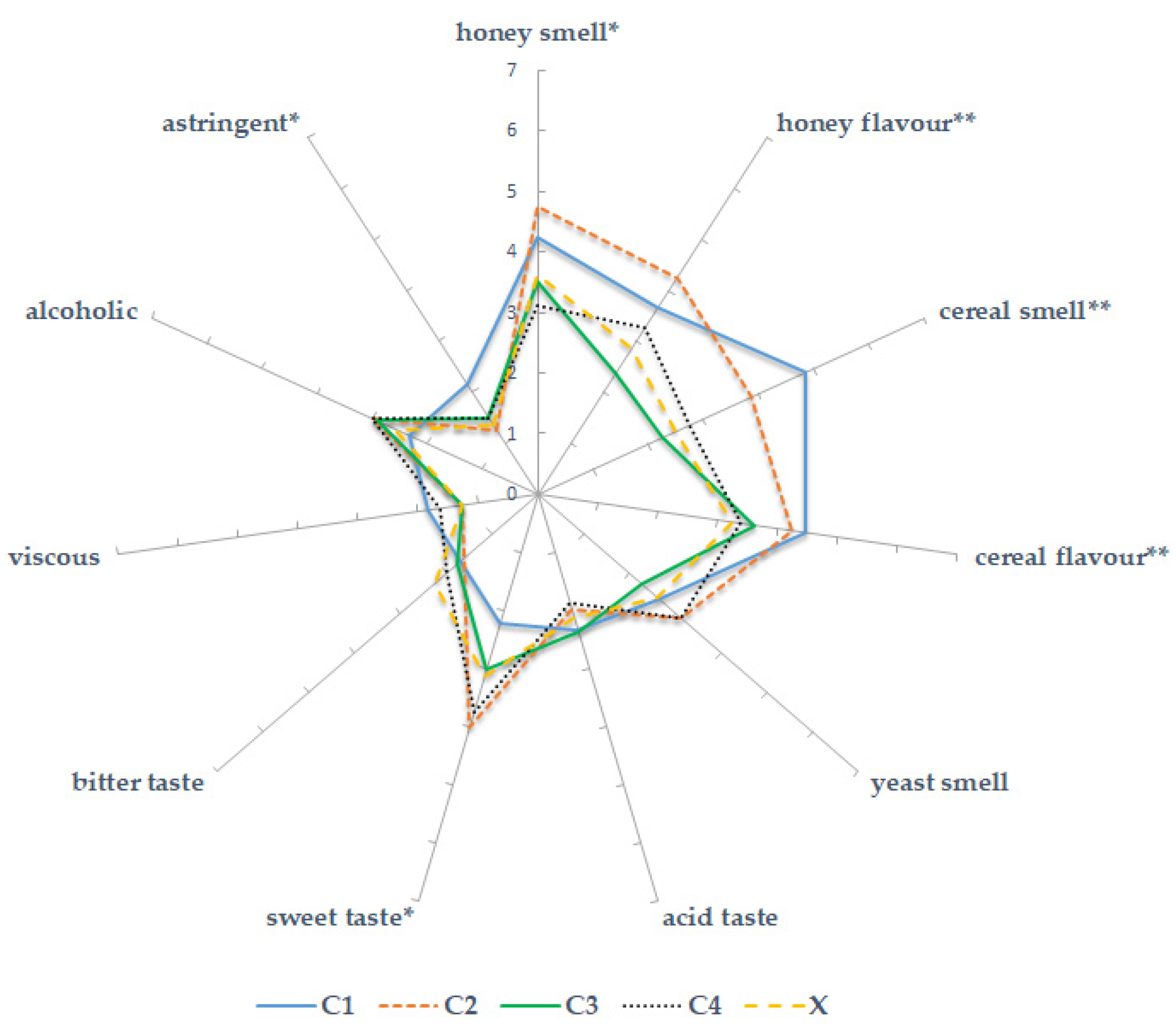
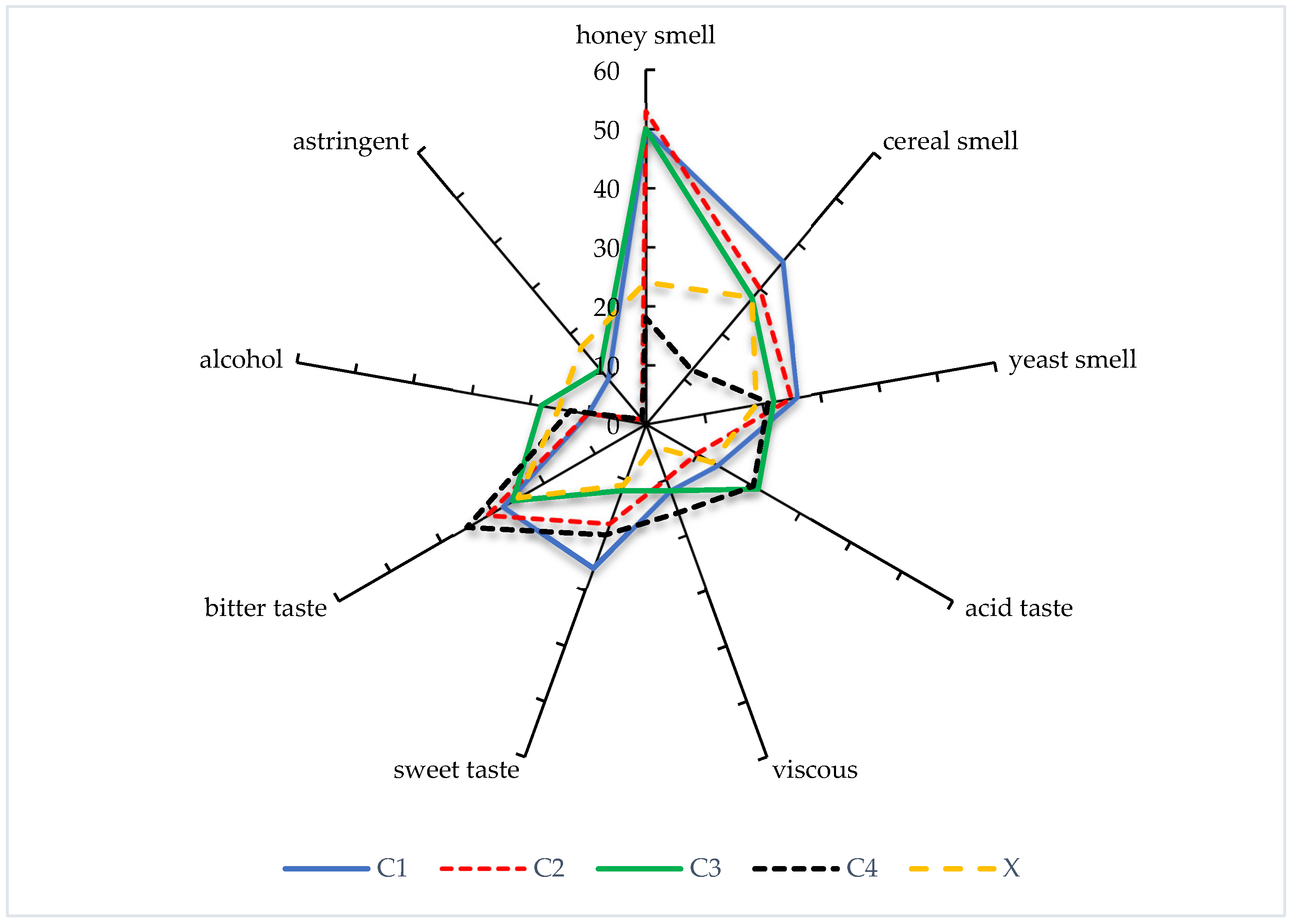
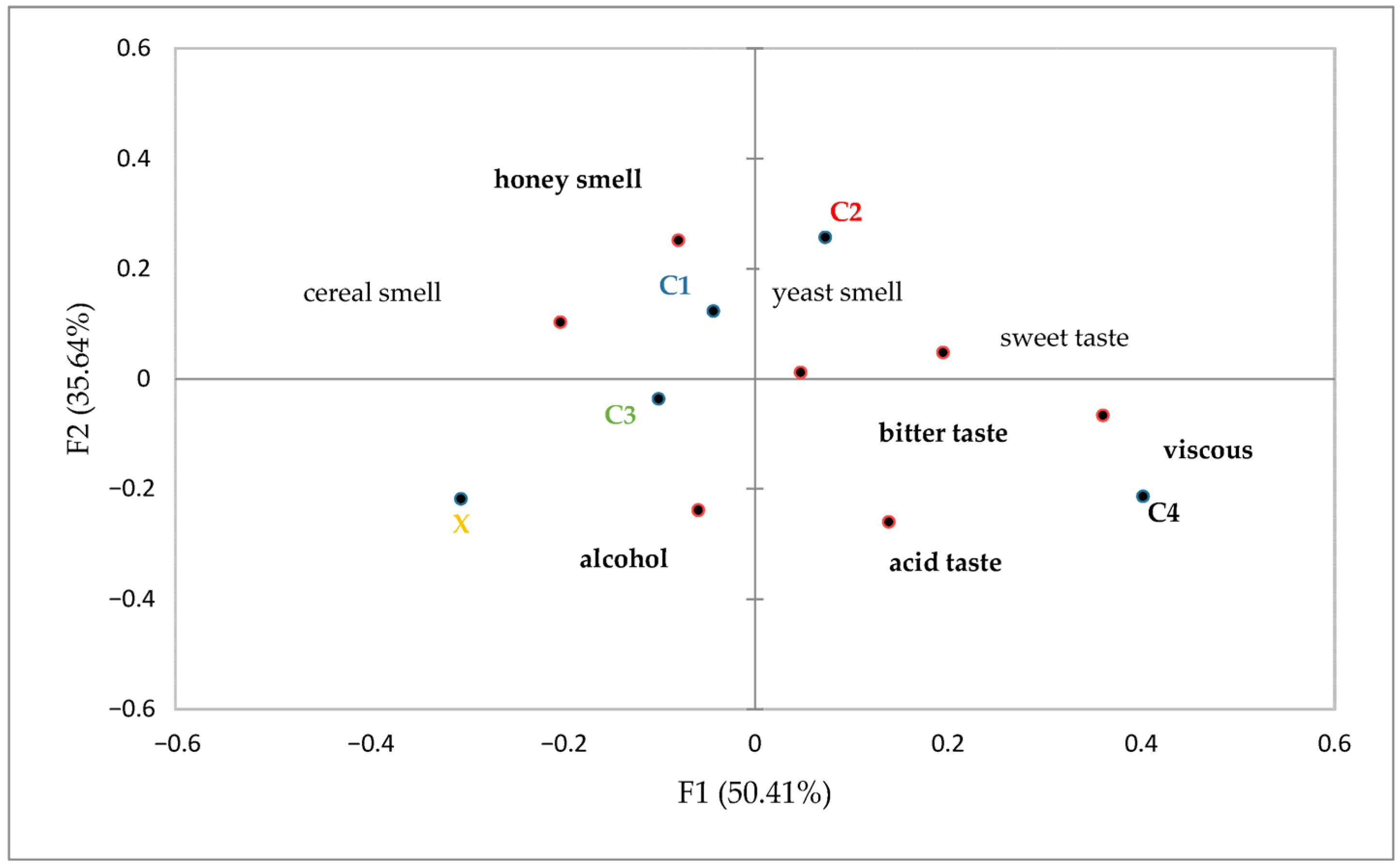

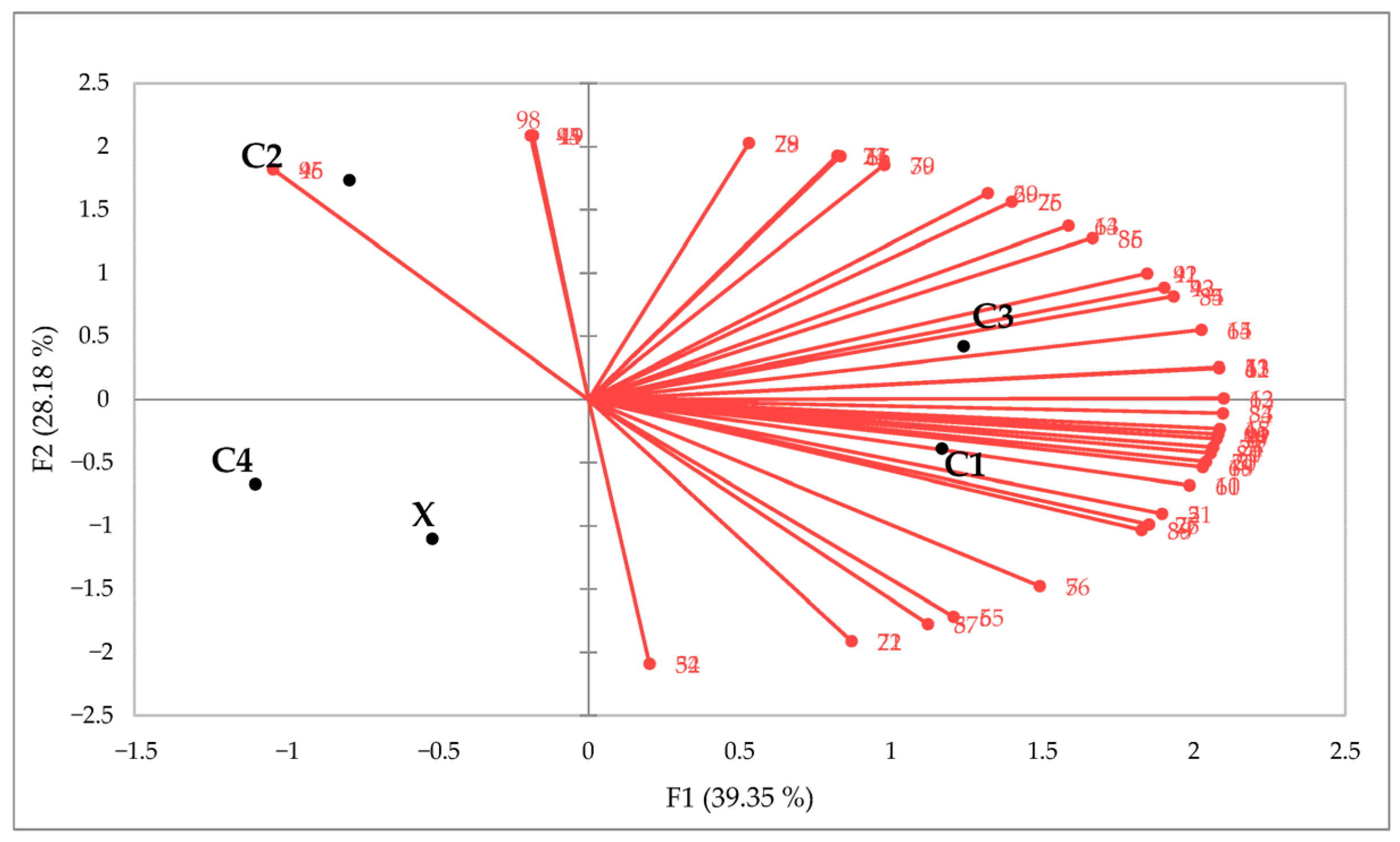
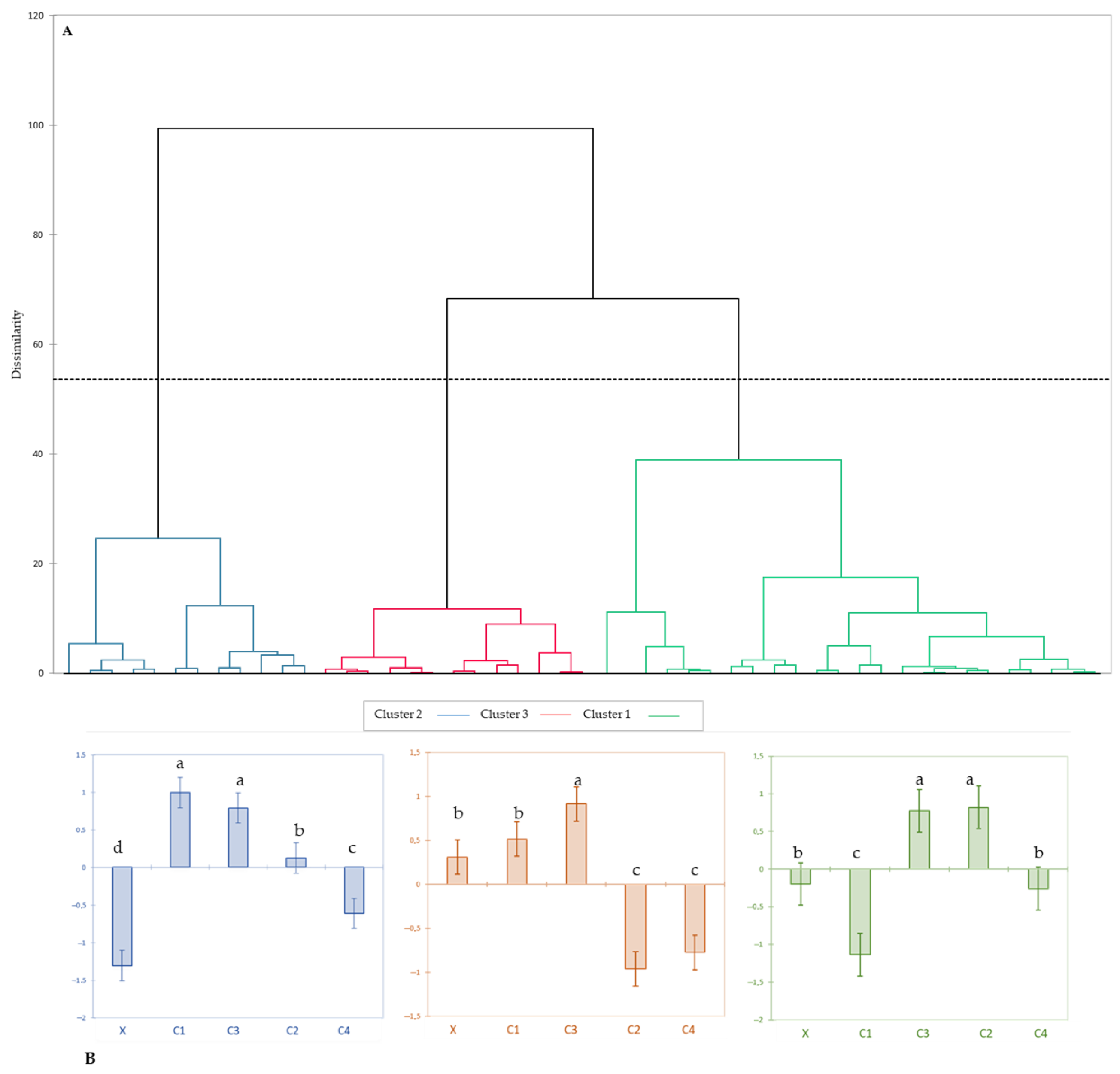
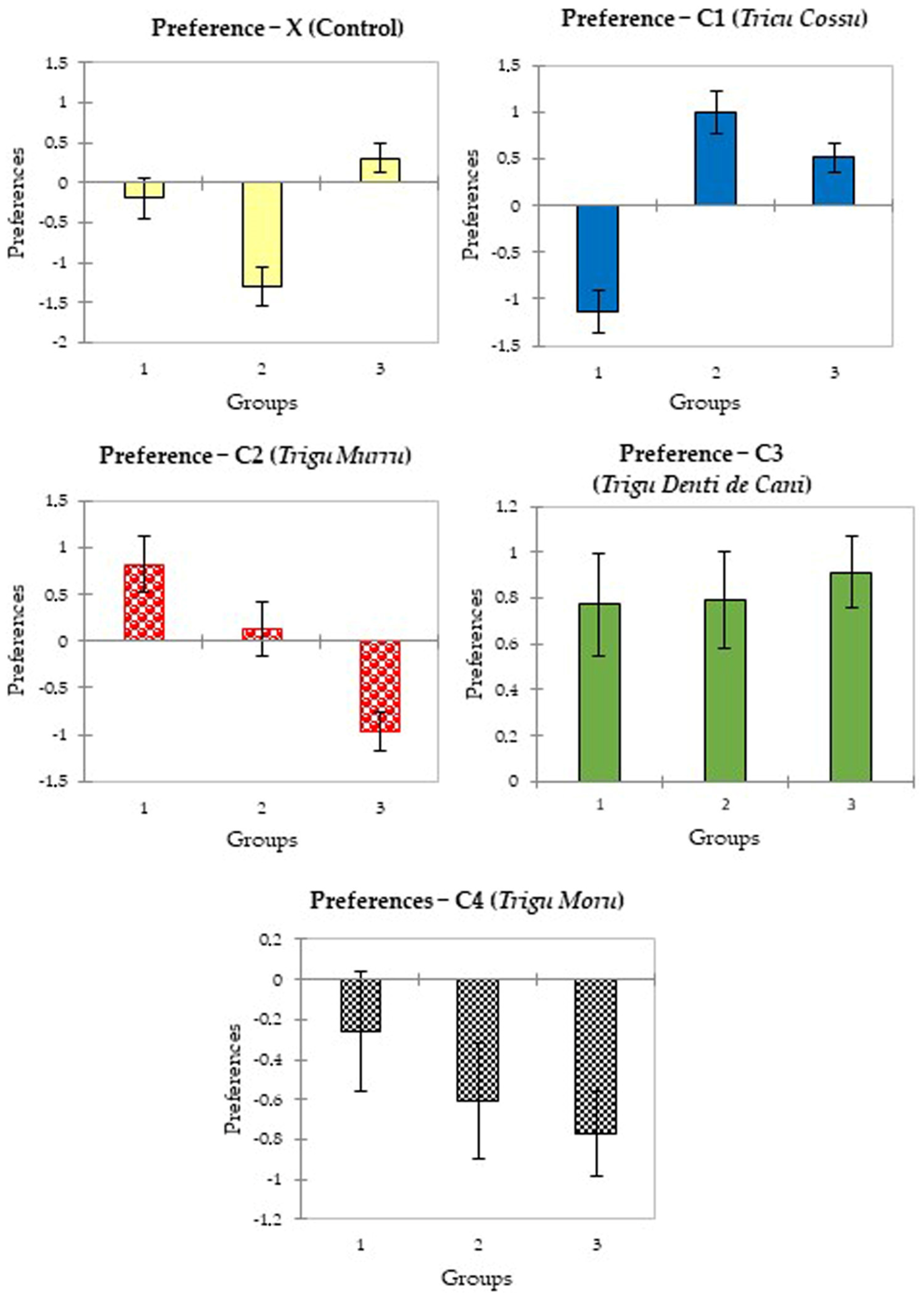
| Parameter | X | C1 | C2 | C3 | C4 |
|---|---|---|---|---|---|
| Alcohol (% v/v) | 5.02 ± 0.00 b | 6.22 ± 0.00 a | 4.41 ± 0.00 c | 4.92 ± 0.20 bc | 5.04 ± 0.00 b |
| Density (g/cm3) | 1.01446 ± 0.00071 a | 1.01154 ± 0.00007 b | 1.01441 ± 0.00001 a | 1.01311 ± 0.00008 ab | 1.01228 ± 0.00001 b |
| Re (real extract) (% w/w) | 5.96 ± 0.19 a | 5.62 ± 0.00 ab | 5.74 ± 0.01 ab | 5.58 ± 0.04 ab | 5.41 ± 0.00 b |
| Ae (app. extract) (% w/w) | 4.16 ± 0.18 a | 3.41 ± 0.01 b | 4.15 ± 0.01 a | 3.82 ± 0.02 ab | 3.60 ± 0.00 ab |
| Oe (original extract) (% w/w) | 13.47 ± 0.22 b | 14.87 ± 0.00 a | 12.37 ± 0.06 c | 12.97 ± 0.31 bc | 12.99 ± 0.01 b |
| RDF (real deg. of ferm.) | 57.57 ± 0.64 bc | 64.08 ± 0.01 a | 55.28 ± 0.16 c | 58.65 ± 0.74 b | 59.99 ± 0.01 b |
| Foam stability (s/3 cm) | 337 ± 1 a | 272 ± 2 b | 298 ± 11 ab | 258 ± 25 bc | 249 ± 2 c |
| TPC (GAE mg/L) | 335.0 ± 6.0 a | 331.2 ± 7.1 ab | 283.1 ± 22.5 b | 334.9 ± 3.0 a | 339.0 ± 9.2 a |
| Color (EBC unit) | 7.11 ± 0.01 b | 9.00 ± 0.13 a | 6.45 ± 0.69 c | 6.99 ± 0.18 b | 7.65 ± 0.07 b |
| pH | 4.57 ± 0.03 b | 4.50 ± 0.01 b | 4.63 ± 0.02 ab | 4.68 ± 0.00 a | 4.70 ± 0.01 a |
| Chemical Class | Name | RT | RIcalc | X | C1 | C2 | C3 | C4 |
|---|---|---|---|---|---|---|---|---|
| Alcohols | 2-methylpropan-1-ol | 7.61 | 654 | - | - | 0.65 ± 0.05 | - | - |
| 3-methylbutan-1-ol | 12.35 | 738 | 4.31 ± 0.12 d | 6.50 bc ± 0.7 | 8.85 ± 0.31 a | 5.44 ± 0.51 c | 7.21 ± 0.40 b | |
| 2-methylbutan-1-ol | 12.54 | 741 | 1.13 ± 0.02 b | 2.10 ± 0.37 a | 2.14 ± 0.11 a | 1.30 ± 0.10 b | 1.45 ± 0.04 b | |
| 2-Furanmethanol | 19.59 | 859 | 0.22 ± 0.00 | - | 0.29 ± 0.02 | 0.08 ± 0.01 | 0.11 ± 0.02 | |
| 1-Hexanol | 20.42 | 873 | 0.02 ± 0.00 | - | 0.07 ± 0.00 | 0.02 ± 0.00 | 0.03 ± 0.00 | |
| 1-Heptanol | 26.5 | 973 | - | - | 0.02 ± 0.00 | - | - | |
| 2-ethylhexan-1-ol | 29.75 | 1032 | - | - | - | - | 0.03 ± 0.00 | |
| 1-Octanol | 32.1 | 1074 | 0.02 ± 0.00 | - | 0.06 ± 0.01 | 0.03 ± 0.00 | 0.03 ± 0.00 | |
| 2-Nonanol | 33.73 | 1102 | 0.39 ± 0.01 | - | 0.83 ± 0.06 | 0.31 ± 0.01 | 0.41 ± 0.03 | |
| 2-phenylethan-1-ol | 34.56 | 1118 | 5.09 ± 0.03 b | 4.00 ± 0.09 c | 16.07 ± 0.63 a | 10.99 ± 0.77 b | 11.86 ± 0.89 b | |
| 2-Decanol | 38.86 | 1202 | 0.25 ± 0.00 | - | 0.66 ± 0.03 | 0.17 ± 0.01 | 0.29 ± 0.01 | |
| 1-Decanol | 42.26 | 1273 | 0.04 ± 0.00 | - | 0.12 ± 0.01 | 0.04 ± 0.00 | 0.05 ± 0.00 | |
| 2-Undecan-1-ol | 43.65 | 1302 | 0.59 ± 0.06 | - | 1.28 ± 0.09 | 0.39 ± 0.02 | 0.54 ± 0.05 | |
| 2-Methoxy-4-vinylphenol | 44.27 | 1316 | 1.22 ± 0.07 | 1.30 ± 0.00 | 1.34 ± 0.11 | 0.90 ± 0.22 | 0.88 ± 0.18 | |
| 1-Dodecanol | 51.22 | 1475 | 0.02 ± 0.00 | - | 0.03 ± 0.00 | 0.02 ± 0.00 | 0.01 ± 0.00 | |
| 2.4-Di-tert-butylphenol | 52.63 | 1509 | 0.52 ± 0.06 | - | 1.45 ± 0.26 | 0.13 ± 0.07 | 0.37 ± 0.11 | |
| Esters | Ethyl acetate | 7.12 | a | 4.80 ± 0.44 | 3.03 ± 0.29 | 3.74 ± 0.62 | 3.80 ± 0.02 | |
| 2-Methylpropyl ethanoate | 14.45 | 775 | 0.14 ± 0.03 | 0.09 ± 0.00 | 0.14 ± 0.01 | 0.09 ± 0.09 | ||
| Ethyl butanoate | 16.05 | 803 | 0.15 ± 0.00 | 0.10 ± 0.01 | 0.10 ± 0.00 | 0.08 ± 0.01 | ||
| 3-methylbutyl ethanoate | 20.76 | 878 | 7.94 ± 0.48 ab | 8.82 ± 0.79 a | 4.26 ± 0.07 d | 5.73 ± 0.34 c | 6.34 ± 0.33 bc | |
| 2-methylbutyl ethanoate | 20.88 | 880 | 0.82 ± 0.02 | 1.30 ± 0.17 | 0.53 ± 0.00 | 0.67 ± 0.08 | 0.57 ± 0.03 | |
| Ethyl hexanoate | 28.01 | 998 | 2.05 ±0.19 | 2.01 ± 0.09 | 1.04 ± 0.27 | 1.31 ± 0.14 | ||
| Hexyl ethanoate | 28.8 | 1012 | 0.23 ± 0.01 b | 3.97 ± 0.26 a | 0.14 ± 0.00 b | 0.10 ± 0.03 c | 0.11 ± 0.00 c | |
| 3-Methylbutyl 2-methylpropanoate | 28.98 | 1018 | 0.22 ± 0.02 | 0.03 ± 0.00 | 0.01 ± 0.00 | 0.02 ± 0.00 | ||
| Hethyl heptanoate | 33.43 | 1098 | 0.06 ± 0.00 | 0.08 ± 0.00 | 0.04 ± 0.01 | 0.05 ± 0.00 | ||
| Ethyl octanoate | 38.53 | 1196 | 12.86 ± 0.42 b | 18.80 ± 0.07 a | 9.17 ± 0.86 c | 8.84 ± 0.42 c | 10.82 ± 1.50 bc | |
| phenethyl acetate | 41.51 | 1258 | 3.83± 0.29 ab | 3.42 ± 0.13 b | 3.64 ± 0.08 b | 5.06 ± 0.44 a | 4.00 ± 0.69 ab | |
| Methyl geranate | 44.52 | 1322 | 0.18 ± 0.02 | 0.23 ± 0.01 | 0.09 ± 0.00 | 0.15 ± 0.01 | ||
| Ethyl decanoate | 47.75 | 1394 | 15.03 ± 0.14 b | 20.59 ± 0.45 a | 9.85 ± 0.83 c | 19.13 ± 2.13 ab | 17.69 ± 1.96 ab | |
| Ethyl 9-decenoate | 47.38 | 1385 | - | 0.85 ± 0.28 | - | 0.25 ± 0.02 | ||
| 3-methylbutyl octanoate | 49.96 | 1445 | 0.17 ± 0.01 | 0.18 ± 0.02 | 0.38 ± 0.04 | 0.21 ± 0.07 | ||
| Ethyl dodecanoate | 55.96 | 1592 | 8.12 ± 0.07 ab | 2.30 ± 0.21 c | 6.01 ± 0.40 b | 10.13 ± 1.27 a | 8.90 ± 1.90 ab | |
| Ethyl hexadec-9-enoate | 71.48 | 1974 | 0.09 ± 0.06 | 0.19 ± 0.07 | 0.25 ± 0.05 | 0.04 ± 0.03 | ||
| Ethyl hexadecanoate | 72.36 | 1993 | 0.25 ± 0.10 | 0.46 ± 0.02 | 1.64 ±0.36 | 1.10 ± 0.58 | ||
| Organic acids | Hexanoic acid | 27.1 | 983 | 0.50 ± 0.06 | 0.75 ± 0.03 | 0.53 ± 0.06 | 0.62 ± 0.06 | |
| Octanoic acid | N/F | 10.15 ± 0.55 a | 10.62 ± 1.10 a | 12.67 ± 0.52 a | 9.33 ± 0.76 a | 9.60 ± 2.60 a | ||
| Nonanoic acid | 41.97 | 1267 | 0.15 ± 0.01 | 0.22 ± 0.01 | 0.13 ± 0.01 | 0.13 ± 0.03 | ||
| n-Decanoic acid | 46.97 | 1376 | 15.20 ± 0.37 a | 10.13 ± 0.10 bc | 8.66 ± 0.19 c | 10.69 ± 0.15 b | 8.68 ± 1.00 c | |
| Dodecanoic acid | 54.73 | 1561 | 1.49 ± 0.05 | 0.71 ± 0.01 | 1.03 ± 0.01 | 0.59 ± 0.30 | ||
| 9-Hexadecenoic acid | 70.03 | 1943 | - | - | - | - | ||
| Terpenes | 3.3.6-Trimethyl-1.5-heptadiene | 22.35 | 904 | 0.03 ± 0.00 | 0.04 ± 0.01 | - | - | |
| Limonene | 29.88 | 1034 | 0.01 ± 0.00 | 0.02 ± 0.00 | 0.01 ± 0.00 | 0.01 ± 0.00 | ||
| β-Phellandrene | 29.99 | 1036 | 0.03 ± 0.00 | 0.05 ± 0.01 | 0.02 ± 0.00 | 0.03 ± 0.00 | ||
| 3.7-dimethylocta-1.3.6-triene | 30.72 | 1049 | 0.03 ± 0.00 | 0.05 ± 0.01 | 0.03 ± 0.00 | 0.03 ± 0.00 | ||
| Linalool | 33.65 | 1101 | 0.23 ± 0.00 c | 0.95 ± 0.03 a | 0.40 ± 0.01 b | 0.22 ± 0.02 c | 0.21 ± 0.05 c | |
| (3R) -3.7-dimethyloct-6-en-1-ol | 40.09 | 1228 | 0.21 ± 0.01 | 0.33 ± 0.04 | 0.10 ± 0.01 | 0.15 ± 0.01 | ||
| Geraniol | 41.26 | 1252 | 0.02 ± 0.00 | 0.07 ± 0.00 | 0.02 ±0.00 | 0.03 ± 0.00 | ||
| (Z)-beta-farnesene | 50.33 | 1454 | 0.08 ± 0.00 | 0.11 ± 0.01 | 0.12 ± 0.06 | 0.10 ± 0.04 | ||
| α-Humulene | 50.93 | 1468 | 0.10 ± 0.00 | 0.09 ± 0.02 | 0.39 ± 0.25 | 0.21 ± 0.20 | ||
| Terpineol | 38.76 | 1200 | 0.24 ± 0.01 | - | 0.05 ± 0.00 | 0.02 ± 0.00 | 0.21 ± 0.00 | |
| Other | 2-Nonanone | 33.14 | 1093 | 0.02 ± 0.00 | 0.14 ± 0.01 | 0.02 ± 0.00 | 0.05 ± 0.00 | |
| 4H-Pyran-4-one. 2.3-dihydro-3.5-dihydroxy-6-methyl- | 36.06 | 1148 | 0.10 ± 0.00 | 0.07 ± 0.02 | 0.04 ± 0.00 | 0.05 ± 0.01 | ||
| Styrene | 21.64 | 892 | 0.34 ± 0.02 | 0.27 ± 0.02 | 0.17 ± 0.04 | 0.21 ± 0.02 | ||
| Unknown | 29.6 | 1029 | 0.12 ± 0.01 | 0.17 ± 0.01 | 0.08 ± 0.00 | 0.09 ± 0.01 | ||
| Spiropentane, butyl- | 42.73 | 1283 | 0.19 ± 0.02 | 0.42 ± 0.03 | 0.13 ± 0.01 | 0.19 ± 0.04 |
| Descriptor | X | C1 | C2 | C3 | C4 |
|---|---|---|---|---|---|
| honey smell | 0.316 a | 0.658 b | 0.697 b | 0.654 b | 0.237 a |
| cereal smell | 0.368 b | 0.474 b | 0.395 b | 0.368 b | 0.158 a |
| yeast smell | 0.250 a | 0.342 ab | 0.329 ab | 0.289 a | 0.276 a |
| acid taste | 0.171 ab | 0.184 ab | 0.132 a | 0.289 b | 0.276 b |
| viscous | 0.053 a | 0.158 ab | 0.132 ab | 0.158 ab | 0.211 b |
| sweet taste | 0.145 a | 0.342 b | 0.237 ab | 0.158 a | 0.263 ab |
| bitter taste | 0.329 a | 0.368 ab | 0.408 ab | 0.342 ab | 0.461 b |
| alcohol | 0.197 a | 0.132 a | 0.132 a | 0.237 b | 0.171 a |
| astringent | 0.224 b | 0.132 ab | 0.013 a | 0.158 b | 0.013 a |
Disclaimer/Publisher’s Note: The statements, opinions and data contained in all publications are solely those of the individual author(s) and contributor(s) and not of MDPI and/or the editor(s). MDPI and/or the editor(s) disclaim responsibility for any injury to people or property resulting from any ideas, methods, instructions or products referred to in the content. |
© 2025 by the authors. Licensee MDPI, Basel, Switzerland. This article is an open access article distributed under the terms and conditions of the Creative Commons Attribution (CC BY) license (https://creativecommons.org/licenses/by/4.0/).
Share and Cite
Sanna, M.; Farbo, M.G.; Valentoni, A.; Melis, R.; Porcu, M.C.; Piu, P.P.; Serra, M.; Pretti, L. Sensory Evaluation and Physicochemical Analysis of Beers with Old Sardinian Wheats. Appl. Sci. 2025, 15, 9138. https://doi.org/10.3390/app15169138
Sanna M, Farbo MG, Valentoni A, Melis R, Porcu MC, Piu PP, Serra M, Pretti L. Sensory Evaluation and Physicochemical Analysis of Beers with Old Sardinian Wheats. Applied Sciences. 2025; 15(16):9138. https://doi.org/10.3390/app15169138
Chicago/Turabian StyleSanna, Manuela, Maria Grazia Farbo, Antonio Valentoni, Riccardo Melis, Maria Cristina Porcu, Piero Pasqualino Piu, Marco Serra, and Luca Pretti. 2025. "Sensory Evaluation and Physicochemical Analysis of Beers with Old Sardinian Wheats" Applied Sciences 15, no. 16: 9138. https://doi.org/10.3390/app15169138
APA StyleSanna, M., Farbo, M. G., Valentoni, A., Melis, R., Porcu, M. C., Piu, P. P., Serra, M., & Pretti, L. (2025). Sensory Evaluation and Physicochemical Analysis of Beers with Old Sardinian Wheats. Applied Sciences, 15(16), 9138. https://doi.org/10.3390/app15169138






